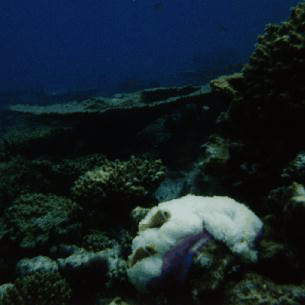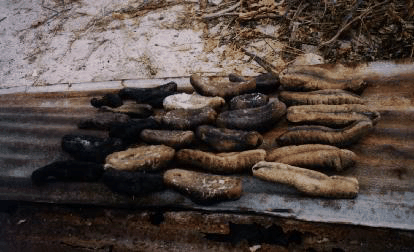
According to Jochen Gommers, there was a pest of crowns of thorn
(Acanthaster planci) about five years ago. This lead to severe damage
to the corals in general and the housereef in particular. One major reaason
was the harvesting of the triton shell (Charonia tritonis) for souvenir
purposes. Since then the dive base crew occasionally collects Acanthaster
to avoid another pest. During subsequent years, the reef recovered and
was fully restored prior to the exceptionally high water temperatures (up
to 36_ C) in February and March of this year which was the cause for another
deterioration of the overall state of the coral.
We generally observed only few living hard and soft corals at all sites.
Less than 5% were healthy and some colonies were only partially affected
by coral bleaching. In most cases more than 80% of a colony was bleached.
Considering coral populations, between 5% and 10% were bleached depending
on the depth. We obsereved less bleaching in shallow water but at the same
time a larger fraction of the coral populations was already dead.
Hard corals suffered most from the high water temperatures with more
than 85% of the population dead. This result is supported by observations
during a night dive (Housereef 2). Even at night we could find almost no
living hard corals. Usually, the corals were covered with a thin layer
of algae, indicating that they died less than a year ago. This, in turn,
suggests that the desastrous coral bleaching immediately followed the high
water temperatures. During our stay, we observed only the declining part
of the bleaching process. In some locations (e.g. Remas Faru) and particularly
in shallow water the corals were already entirely covered by a thick layer
of algae. We were surprised how fast these processes apparently take place.
According to our data, the coral bleaching seems to correlate well with the degree of exposition or shelteredness of a reef. In sheltered locations (e.g. Housereef 1 and 2, Pineapple island) the amount of dead corals was very high and almost the same in both transect depths (~90%). Although, in more exposed reefs (e.g. Namnetti Tila, Remas Faru), we observed differences in the fractions of dead coral as well as corals affected by actual coral bleaching depending on the transect depth. In ten meters depth, fewer corals were dead, but at the same time a larger fraction was affected by coral bleaching. The increased water movement in exposed reefs probably kept the water temperature lower in greater depth and thus at least delayed the bleaching process.

Figure 3: Maldivian anemonefish in a bleached anemone. The
surrounding corals are mostly dead and covered by a thin layer of algae.
Porites and Gorgonians were seldom observed and therefore no definite
conclusion can be made. Most anemones were bleached, especially in shallow
water.
Small specimens of the giant clam (Tridacna sp.) with less
than 30 cm length and the sea cucumber Bohadschia graeftei
were the most frequently observed invertebrates. Interestingly, the latter
was significantly more frequently observed in the housereef around Angaga
and in particular on the transects in 3m depth than in any other
site. Further investigations would be required to check whether this is
a consequence of the potentially manured reefs near resorts or other population
centres.
As mentioned before, the crew of the dive base occasionally collects
crowns of thorn, in order to avoid another pest. This procedure seems reasonable
as long as the triton shell has not returned to Angaga and since they did
not seem to exaggerate their harvesting.
On the transects, we never observed triton snails (Charonia tritonis), lobsters (Panulirus sp.) and banded coral shrimps (Stenopus hispidus). However, on the night dive (see Housereef 2, section 3.2) we spotted 20-30 lobsters in one location as well as five banded coral shrimps. Besides, we observed three crown of thorn starfish (Acanthaster planci), two diadema (Diadema sp.) and five pencil urchins (Heterocentrotus mammilatus).

Figure 4: On native Maldivian islands, many people are harvesting
sea cucumbers, roasting and grinding them in order to sell the powder as
an aphrodisiaca mostly to countries in the far east.
Even though the coral reef was in bad condition, the variety of
the fish species as well as the distribution of the fish size in the different
populations appeared rather normal and undisturbed. However, we had the
impression that the overall population sizes were reduced. At the same
time, we observed a lack of larger marine animals as well as few large
representatives of the different species. This is in accordance to Jochen
Gommers, who stated that the bigger marine animals and sharks in particular
have left the reefs around Angaga. Since any sort of fishing is forbidden
around Angaga, the lack of larger species and speciemens is due to diminished
food resources which is a natural consequence of the reefs state. They
have left in search of more prosperous places.
We spotted very few white tipped reef sharks (Triaenodon obesus)
and one nurse shark (Nebrius concolor) but none of them on the transects.
In the housereef two turtles (Caretta caretta) were frequently seen
when diving or snorkeling. Once we saw a large black-spotted ray (Taeniura
melanospilos) sleeping in the lagoon having a width around 1.5m.
On two days we observed a group of up to three rather small spotted eagle
rays (Aetobatus narinari, width <1m) patrolling the houesereef.
Concerning the target species, there was an obvious lack of larger specimens
of groupers (Cephalopholis sp.). However, sweetlips (Plectorhinchus
sp.) were regularly observed in all sizes. The other species, barramundi
cod (Cromileptis altivelis), bumphead parrotfish (Bolbometopon
muricatum) and humphead wrasse (Cheilinus undulatus) do not
live around Angaga. The butterfly fish (Chaetodon sp.) populations
appeared to in normal condition with respect to size and variety.
Note that the Maldivian government sold the fishery rights in their territorial waters to Japan. The Japanese high tech fishery fleet imposes a considerable threat to larger marine animals even though they may not enter the different atolls. In addition, many Maldivian people earn their living from selling shark fins to different asian countries in the far east and shark teeth to tourists.